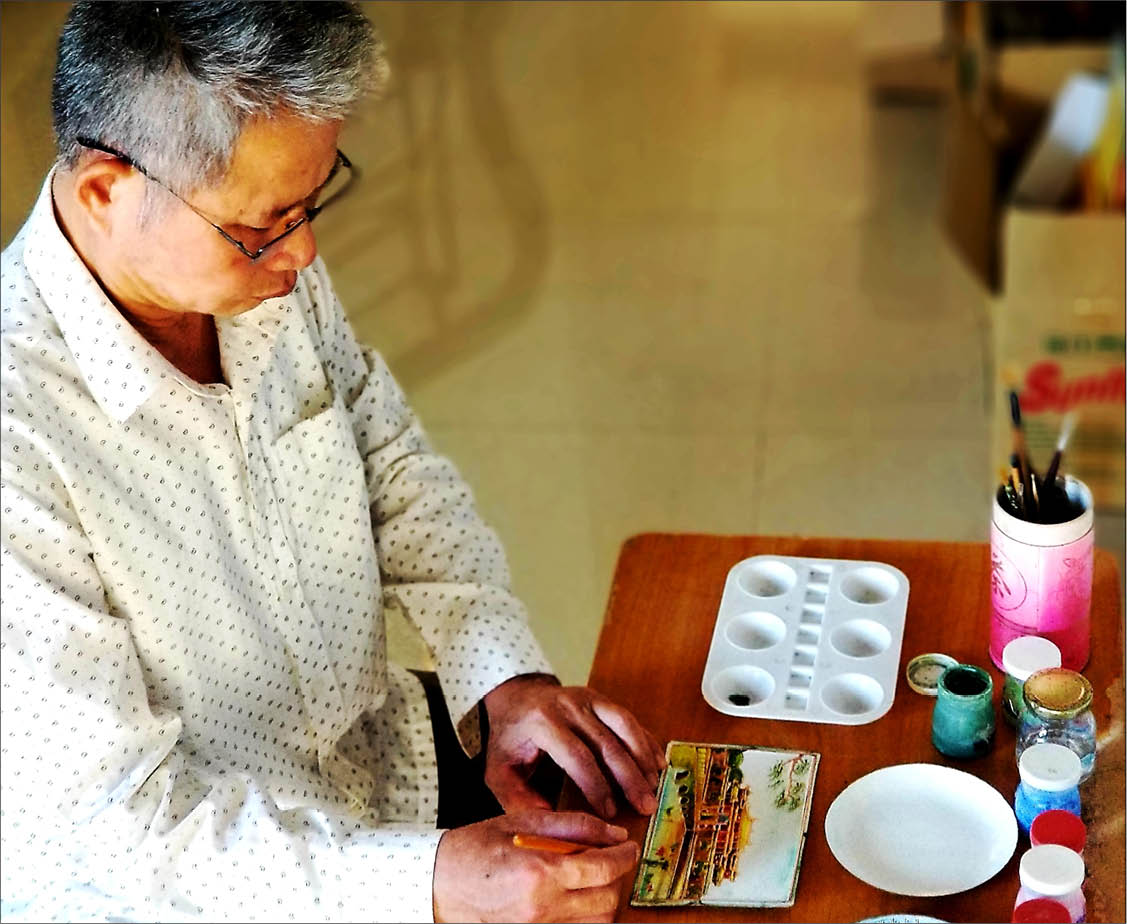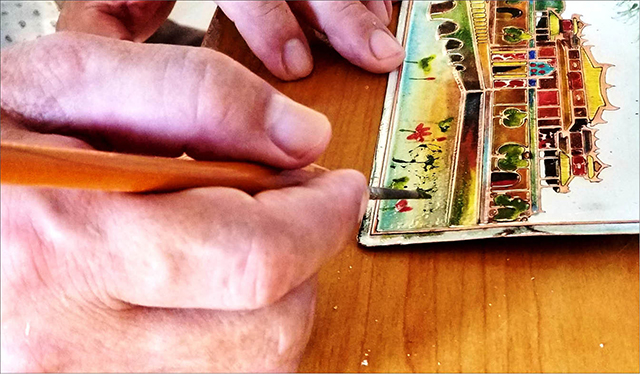
Mr. Nguyen Phuoc Dien always creates new products.
Quitting the career of a doctor to pursuit Phap Lam painting
“I have moved to as far as Thuy Phuong (Huong Thuy Town), not living in Hue anymore.” His message on my phone reminds me of his small house of about 60m2 in an alley on Nguyen Khuyen St., Hue City at the beginning which is a rectangular board saying: “Phap Lam Paintings.”
It was his home where he started his passion about ten years ago. At the time, tourists and local people were still unaware of Phap Lam enamel, and Mr. Dien was working as a doctor for a living. No one knows why he decided to quit his job to restart with the brush.
“Lingering at museums, Phap Lam paintings took my heart.” That was why he started his career. He traveled everywhere to learn and find documents, accumulating knowledge and deciding on his style.
His first paintings were a failure. He threw away hundreds of faulty paintings. Many people thought he was crazy to do the work that did not belong to him. “I spent many sleepless nights just thinking about a certain mistake,” said Mr. Dien.
About one year after the first stroke on the copper sheet, Mr. Dien was successful. “In order to paint, besides knowledge of fine arts, it is necessary to combine it with knowledge about sciences such as mathematics, physics, chemistry, as well as logic thinking. I did not succeed before because I failed to combine them properly,” explained Mr. Dien.

Phap Lam paintings need meticulousness and care.
He soon displayed his paintings in Hue Festivals. In his eyes, his passion and efforts are incalculable. But tourists ignored his paintings though they are loaded with lots of culture and history.
Tourists’ ignorance left his hundreds of fine paintings untouched with dust. His efforts to rescue a special line of painting was not welcomed by the market. Again, it was another failure.
“No one noticed my paintings among myriads of products on display at the time. I was so sad, and my wife was, too. It was not just about money...,” confided Mr. Dien.
Not materialistic value only
There was very little demand at the beginning. In order not to waste his investment in art, he decided to do “the most essential thing”: it was promotion.
Besides displaying them, he told his customers about the history, the significance and even the steps to make a Phap Lam painting. Even quick-minded artists cannot figure out the complicated process of making a Phap Lam painting.
His paintings are a combination of many handicrafts such as jewelry making, metal carving, pottery making, copper casting, etc. That makes Phap Lam unique. Each product has a very special value.
Selection of materials is very important. It must be sheets of pure copper, 4-5mm thick. They are then cut into the intended size and cleaned.
After that, a layer of color enamel is coated on the surface, then another layer of white enamel as the background of the painting. It is then heated at an appropriate temperature to settle the enamel coat. Patterns are then drawn; and the painting is heated again to finish.
According to Mr. Dien, Phap Lam paintings are completely handmade. Paint is not available on the market either and artists have to research and make it themselves.
“After a long time of promotion, my Phap Lam paintings now have a stable position in the customer. Many foreign customers ordered a big number of paintings at the price from 600.000-2.000.000 dongs/each. Phap Lam painting can last hundreds of years. Some people had seen may paintings before, but not until three years later did they buy them,” said Mr. Dien.
Mr. Dien is now among just a few artists who have revived the line of Phap Lam painting. His paintings depict historical relics and landscapes in Hue. His 10 patterns have been valued as typical by experts; and he is going to introduce other more impressive ones.
Phap Lam art was introduced into Vietnam during Emperor Minh Mang’s era (1827). Phap Lam was used to decorate palaces in Hue, both in and outside. Started during Minh Mang’s era, thrived during Thieu Tri’s era, but it faded then disappeared during Tu Duc’s era.
Story and photos: LE THO
